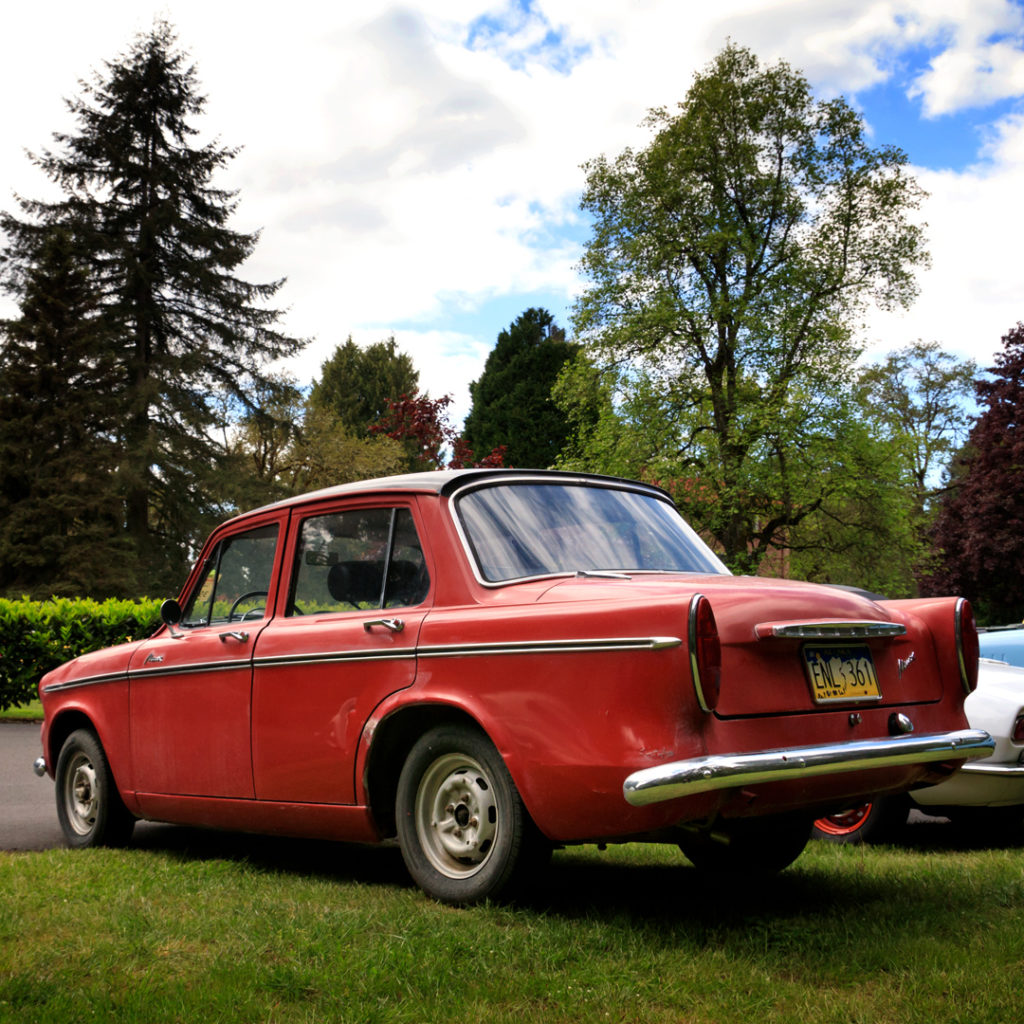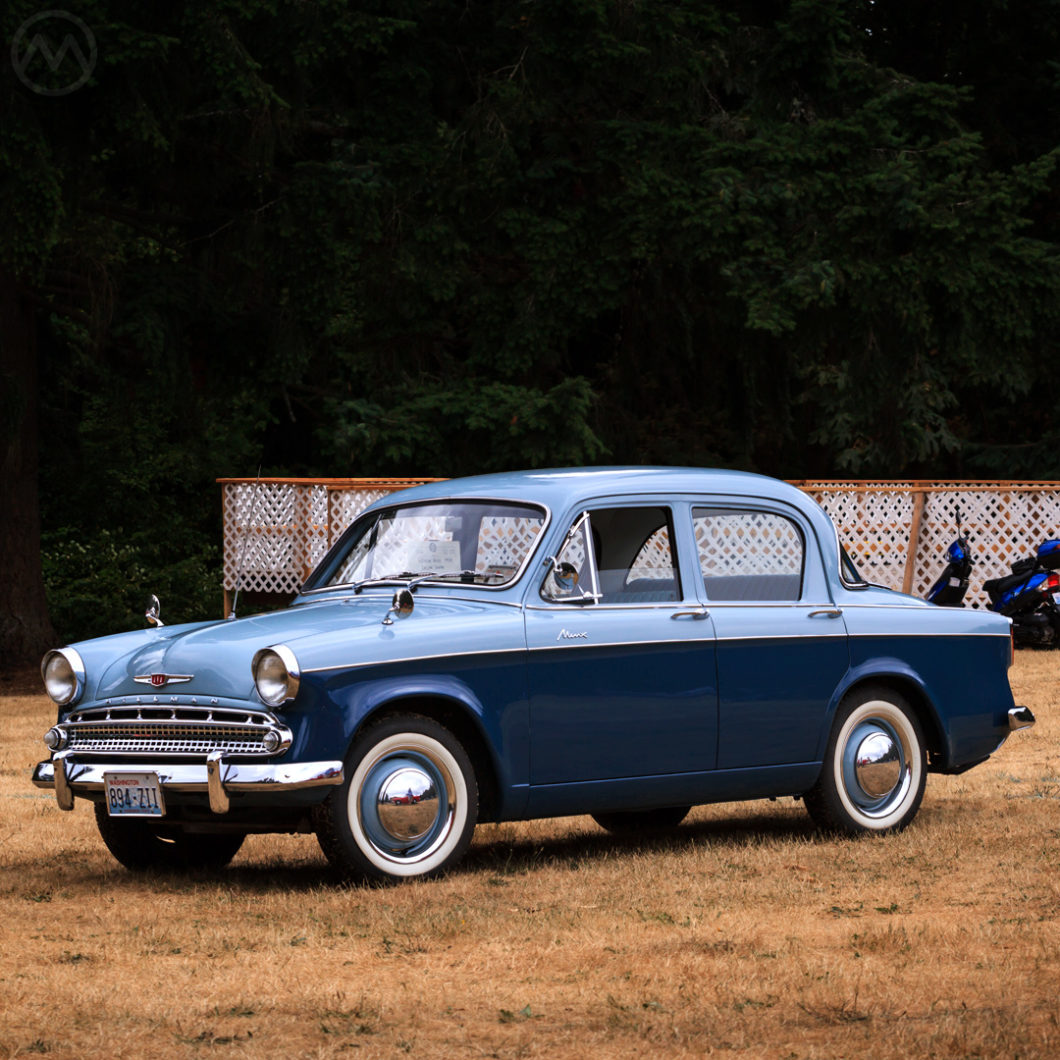It was the MG TC that ignited American interest in imported cars, and of course, primarily sports cars. But in the export-or-die era, it wasn’t long before family fare arrived. The first two non-sporting imports to sell in any real numbers were Austins and Hillmans. In 1950, the two makes sold about 9,000 cars in the USA, split about 60/40 in Austin’s favor.
Though its operation was small, Rootes set up its own distribution HQ in New York and was an early adopter of TV advertising. East coast Americans saw their first TV spot featuring a Minx convertible in 1950. The early 50s Minx (which actually dated to 1948) looked like a scaled down Plymouth, and the ads emphasized its easy to handle small size and weight.
The American export setup was personally overseen by Brian Rootes (Son of company boss Sir William “Billy” Rootes) in New York and Timothy Rootes (son of right hand Sir Reginald “Reggie” Rootes) in Los Angeles from 1950-56. They were very successful in recruiting new dealers and supporting the cars. The “American-ish” look of the products helped.
As Detroit’s cars grew larger in the 1950s, a veritable United Nations of imported brands began to arrive. While Austin slowly receded, Hillman remained a popular choice right up until Detroit’s “compacts” arrived in 1960. In 1959, over 27,000 Hillmans found homes with American buyers – in contention with Fiat and Opel but far behind soaring VW and Renault.
After 1959, when the Sunbeam Alpine debuted, the Minx would play second fiddle to Sunbeam’s MG/Triumph challenger. But the brightest star of the Rootes’ export era in the fifties was the “Audax” Hillman Minx.
The “Audax” platform had actually debuted in October of 1955 as the Sunbeam, but the Minx would be the real volume seller, and it was launched amid particularly inauspicious circumstances during the Suez crisis in the spring of 1956. Among other serious challenges, the U.K. faced fuel rationing for half of the first year of production.
Fortunately, the new Minx was an instant success at home and abroad. Nearly 10% of Hilllman’s 1957 production came stateside. That may have been in part due as much to its good engineering as its transatlantic looks, which had a direct American connection.
Boldly Transatlantic
“Audax” is latin for “Bold.” And sure enough, the plan for Rootes’ new range of vehicles was to be very bold. Rootes was already ahead of the curve on sharing componentry, but the Audax would be a single unibody platform which could underpin many different models. The idea was directly inspired by American platform sharing at GM.
The Rootes Brothers (Billy and Reggie), no strangers to “badge engineering” even in 1952, recognized that such a setup was the only way to achieve the economies of scale needed to be globally competitive.
No doubt the Brothers were reminded of this when, at the end of 1955, they took over the ailing Singer Motors, too small to be competitive on its own.
Work on the Audax began in 1951-2, and in the styling department the Rootes team had some help.
In 1953, the company renewed a long-standing partnership with Raymond Loewy & Associates. It was Loewy’s London office that consulted on styling, and had as far back as 1937. The styling efforts at Rootes were a collaboration, not just a consultancy doing the work for Rootes.
After WW2, staffer Clare Hodgman worked directly from Loewy’s London offices with Ted White, who oversaw Rootes’ internal studios. Nor were they alone. On the Loewy side in the early 1950s Holden “Bob” Koto and John Reinhart were heavily involved in Rootes projects, and Rootes’ own Ted Green and a young Roy Axe were actively involved on the Rootes team.
And yes, Ted White and Ted Green were know as “the two Teds.”
It was this fertile creative environment that produced the many handsome variations of Audax styling, with a heavy, if indirect, influence from American Bob Bourke’s 1953 Studebaker lineup, also a Loewy & Associates creation. The clay models and full development were done at Rootes’ studios.
The car was also thoroughly modern technology wise, with development directed under long-time chief engineer Bernard Winter. It was a sophisticated car by Winter’s usually conservative standards.

Rootes also spent a fortune getting ready to build the car properly – buying suppliers and constructing a £1.75M engine plant to build the new OHV fours that would power the Sunbeam and Hillman versions and which was first used in the outgoing older Minx Mark VIII.
The unibody was strong and light for the era. The shells were built by Pressed Steel, but on hardtops and convertibles, the cars underwent modification and finishing at Thrupp & Mayberly.
The first Audax, the Sunbeam Rapier, debuted the Earl’s Court show in October of 1955.
Available as a hardtop coupe or Convertible, it was a very different car than the Sunbeam MkIII (the final variant of the Sunbeam-Talbot 90) that it replaced. It proved an effective trial run for the volume-oriented Minx, and its earlier debut got the kinks worked out for what was to come.
When all was said and done, the versatile platform would underpin the Sunbeam Rapier, the Alpine sports car (from 1959); Hillman’s Minx and its van derivative, the Husky; the Husky-derived Commer Cob; and the Singer Gazelle – which mixed elements of the Minx and Rapier.
The Audax Minx
The new Minx debuted in London on May 16, 1956, with Sir Reginald Rootes (Reggie) presiding. The car came in three versions – a four-door sedan, a four-door wagon, and a 2-door convertible that used some of the Rapier’s panels. Very soon after the launch, however, the clouds that had gathered for years over the Suez Canal became a storm.
On July 26, Egypt’s President Nasser nationalized the canal and by October the “crisis” was an actual shooting war, and it had far reaching consequences far beyond what they did to Rootes’ car launch. But two effects were very immediate.
First, oil supplies were sharply reduced as tankers could not transit the canal. In November, that led to a return of fuel rationing – which lasted until May of 1957. Second, enormous strain was put on the bank of England to maintain the value of Sterling, key to exchange rates and making money from exports, among other things.
Just days after rationing returned, Chancellor of the Exchequer and soon-to-be Prime Minister Harold Macmillan arranged for an end to hostilities in return for financial support from the United States (who had opposed British Action in Suez) and the International Monetary Fund.
That ended both the military and financial crisis caused by Suez, but not without a year of serious economic anxiety. Macmillan replaced Anthony Eden as Prime Minister in January of ’57, and in his long tenure worked to defuse future conflicts of that nature.
The crisis delayed test drives and some press reviews, but the public liked the Minx almost right away and it didn’t hurt that it was a very economical car and one that got very positive reviews.
The 51-hp 1,390-cc engine (new in the car’s predecessor but still less than 24 months old) was lively and able, and the interior modern and capacious for what was not a very big car. The handling, developed for the Sunbeam with at least some eye towards competition, was reasonable sharp for a family car. A no-frills “Minx Special” was the biggest seller early on.
Rootes also went to great effort to market the cars in European countries, taking loads of cars on a large press tour through France, the low countries, Germany, and Austria. In far off Japan, the Minx design was licensed to Isuzu, who built the cars from the fall of 1956 to 1964.
Cars began to come stateside in October, just as the Crisis reached its zenith and the younger Rootes cousins returned to the U.K. to take on more senior roles in the family firm. John Panks, the director of Rootes Canada, replaced Brian Rootes as the leader of the U.S. operation.
Whatever the doom and gloom situation was in the U.K., it was distant in the USA – and Minx sales were good from the start despite only having a manual transmission. In that first year, the old Husky, related to the previous Minx, continued to be offered in the U.S., but the Minx was where the action was, and the American press generally liked the car far more than its earlier incarnation.

In late 1957, a Series II debuted on both sides of the Atlantic, now with an optional semi-automatic. The Husky was upgraded onto the Audax platform and U.S. sales of that vehicle started to boom as well. In model year 1958, almost 19,000 Hillmans were sold in America.
A Series III and a larger 1,484-cc engine came in 1959 (this engine was already available in the U.K. in late 1957), a year that would prove Hillman’s apogee in the United States.
The Long Tail
Rootes continued to improve the Minx well into the 1960s. The basic platform would be on sale into 1967 even in the United States. But the arrival of the Detroit “compacts,” and specifically the Ford Falcon, put a stake through the heart of the medium and large imported cars.
Hillman’s U.S. sales fell off a cliff, but the Minx was still a good car. In 1960, it was also one of the very few with an optional fully-automatic transmission, new that year. This piece of equipment, the Smiths Easidrive Magnetic Automatic, was well liked at first but proved fussy and complex over time.
In actuality, the only Hillman to truly withstand Detroit’s onslaught was the Husky – a favorite of delivery folks for its utility – but it too faded away in the early 1960s. Hillman added the larger Super Minx to the U.S. line in 1962 but found few takers, and soon dropped it.
The decline of the “family” Hillmans was, of course, offset by the rise of another Audax-derived car – the Sunbeam Alpine Series I-V.
Based on the Husky but looking entirely new, the Alpine sold like hotcakes from the start, soon accounting for a big slice of Rootes’ U.S. volume. It sold so well, in fact, that by 1964 Rootes decided to concentrate all of its American efforts on the Sunbeam name.
A heavily updated Series V Minx bowed in 1963 with a more modern, but clearly evolutionary, 1960s look that from some angles looked a little Volvo-esque. In 1964 it was called the Sunbeam Minx, but sales didn’t really improve with the brand change.
Nevertheless, the final Minxes were very nice cars for the time, with the Alpine’s 1,725-cc engine, four speeds or a Borg-Warner Auto (which replaced the earlier Easidrive). They were good to drive and practical, and by the standards of the day well made.
In Britain, the Minx remained a good seller right up until the end, but it never got anywhere near its 1959 totals again in America. Meanwhile, two long-term impacts of the Suez crisis began to be felt.

First, as commonwealth countries gained more economic and political autonomy (a process sped up by Suez), British firms had fewer outlets for easy exports, which meant fewer captive markets and more competition.
Second, in the wake of the high gas prices and success of bubble cars like the Isetta, Rootes had launched the “APEX” project. After a far-too-long gestation, this became the Hillman Imp (briefly sold in the USA as a Sunbeam). The car was years late to the market and far over budget.
In just four years, the golden age of the Audaxes had given way to the troubled over-extension on the Imp.
Chrysler proved to be Rootes’ lifeline, taking increasingly large stakes in the company and ultimately taking it over, just as Rootes had taken over cash-strapped Singer a decade earlier.
Minx sales ended just as Chrysler was taking full control of Rootes in 1967 (it had bought a 30% stake in 1964). That was not the end of Rootes products in the U.S., however. Under Chrysler a limited set of the “Arrow” range of cars (the Audax’s replacement) was sold at Chrysler dealers as the Sunbeam Arrow and (new) Alpine.
Later, the Hillman Avenger – the first car developed under Chrysler’s ownership, would be sold at Plymouth dealers as the Cricket. Sales total for the 1971 Cricket? 27,600 cars. Just a few hundred more than the ‘59 Minx. It was gone by 1974.

